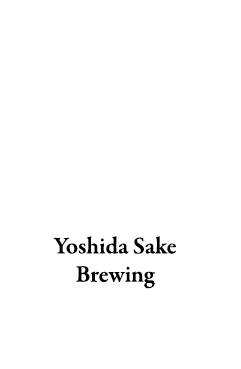


At Yoshida Sake Brewing, we use super soft brewing water selected as one of the top one hundred brand waters in Shimane, and high quality rice raised by local contracted farmers in order to brew fresh, fragrant, and flavorful sake.
We aim to stand at the very pinnacle of Japanese sake,
so our customers feel without thinking "Sake is delicious!"
We make sake not only for those who already like it, but for people who want to try it in the future.
Try our sake once, and you are sure to like it.
In Japan, there has been a custom since ancient times of drinking omiki (sacred sake) after Shinto rituals.
Sake was in fact a communication tool that brought humans and gods together.
Even in the modern day, sake is a communication tool that brings people together.
We hope that all our customers can enjoy drinking Gassan,
as a communication tool that brings them all together.
We're happy to see Gassan enjoyed for all sorts of occasions,
to make food even better, to dine with family, or for special anniversaries.
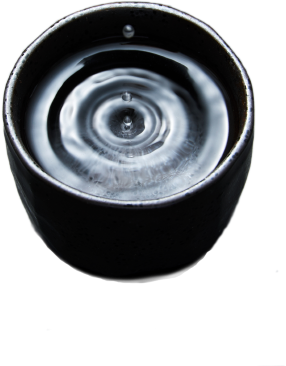
In 2016, we exhibited at "The Fine Sake Awards Japan 2016."
These awards are intended to promote the appeal of Japanese sake,
by serving it in wine glasses to emphasize its fragrance and appearance.
Gassan won gold, which is the highest award given.
Gassan has a fresh and fragrant taste, so it goes well with food other than Japanese food.
As such, it has been highly praised by foreign connoisseurs, and we export it abroad.
Customers can enjoy Gassan in America, Hong Kong, Taiwan, Singapore, Italy,
Australia, Vietnam, Uganda, and Thailand.
This is the appeal of Gassan, which is compatible with many scenes.
We hope you enjoy drinking it unconstrained by conventional ideas.
As a center for rice cultivation, Shimane Prefecture has many sake breweries, each of which brews sake with its own special character. In order to serve the best tasting sake to our customers, we consider it critical for us to raise the level of sake in Shimane Prefecture.
We hope to keep brewing sake that satisfies customers, so they know they made the right choice.


"Gassan" is a mountain visible from Yoshida Sake Brewing in the Hirose district of Yasugi City, Shimane Prefecture.
In the Sengoku period (1467 - 1573), it was the site of Toda Castle, which was said to be impregnable.
In the history of this area, the finest batch of sake brewed that year was labeled "Gassan,"
and presented to noble lord of the region as ichibantaru (lit. "No. 1 barrel" = the finest sake).
Looking back on this historical background,
we named our sake "Gassan" with the aim of "Always brewing the finest sake, worthy of a noble lord."

Yoshida Sake Brewing uses super soft water with a hardness of just 0.3, said to be "the softest water in Japan." This brewing water has been used since restoring the famous "Ocha No Mizu Ido" (Tea Water Well), said to be the best for the "Fumai-ryu Tea Ceremony," held by the successive lords of the Hirose domain in the Edo period, because it was the most delicious water in the areas.
(The location of the well was identified from literature that shows the tea ceremony room from the Fumai-ryu tea ceremony, and water is pumped up from there.)
We use "the best water in the area", so delicious it was recorded in literature. It is said that when brewing sake, hard water with a high mineral content stimulates the growth of yeast. For this reason, hard water is typically more suitable for sake brewing, and it is usually difficult to use soft water.
Nonetheless, Yoshida Sake Brewing daringly chooses to use this super soft water. This is done with consideration for the climate of Japan, where natural water has mostly been soft water since ancient times. The bodies of Japanese people are not well suited for hard water with high mineral content. In some cases, hard water even causes upset stomachs. Furthermore, soft water brings out the aroma and taste of sake, so it can be said that the sake makes it easier for drinkers to smell the wonderful aroma and taste the true flavor of rice.
Soft water is difficult to handle for sake brewers. Yet, we chose this water by combining two strong intentions. One reason was to brew sake that would be beneficial to the drinkers. The other was to brew sake that is deeply rooted into the local area.
We will continue to devote ourselves to sake brewing, with consideration for the local community and our customers.
We use rice raised with care in the lush natural setting of the Nishihida area of Hirose district in Yasugi City.
This high quality rice made by local contracted farmers is procured as brown rice, then carefully polished with a rice mill at our facilities.
Because this local rice has been raised with care, we believe it produces the finest flavor which cannot be replicated anywhere else.


It has a clear and brilliant taste, followed by the umami flavor of rice. Even drinkers who are new to sake can fully enjoy the great flavor of junmai sake with a clear taste while maximizing the taste of rice. There was a revolution involved in making Gassan, in order to preserve this flavor.
We buy high-quality rice from contractor farmers in the Nishihida are of the Hirose district of Yasugi City in the form of brown rice, and polish it with a rice mill in Yoshida Sake Brewery. The polishing ratio of rice people normally eat is about 3% (with the husk of brown rice polished off). At Yoshida Sake Brewing, we polish off 30% or more of both rice for regular sake and rice for junmai (sake made from only rice and rice koji).
Especially for daiginjo (with a polishing ratio of 65%), assuming we prepare 1 ton of rice and polish 65%, 350 kilograms are left. After the rice is pressed in the sake brewing process, sake lees account for 40% of the sake, and the final amount available to drink is about 100 kilograms to 200 kilograms.
*Brown rice lees close to the husk exposed by polishing are made into fertilizer and returned to the field. The white rice part is made into rice flour and ingredients for rice shochu.
*Sake lees are sold as food, and are also used as an ingredient for distilled liquor made using the latest machinery only possessed by Yoshida Sake Brewing in the San'in region (Shimane, Tottori, and northern Yamaguchi prefectures).
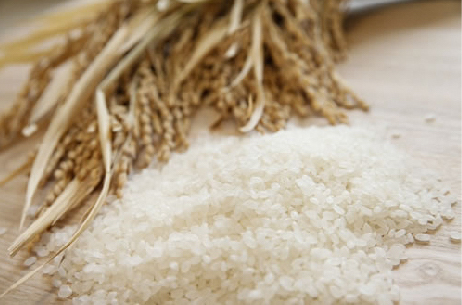
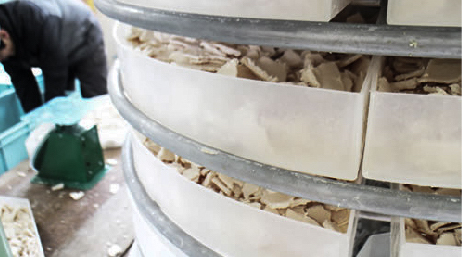
Polished rice is steamed by kurabito (brewery workers) in the steaming room.
The steaming process sterilizes rice with boiling water, and moisture is absorbed by the rice, making it easier to saccharify when making malted rice.
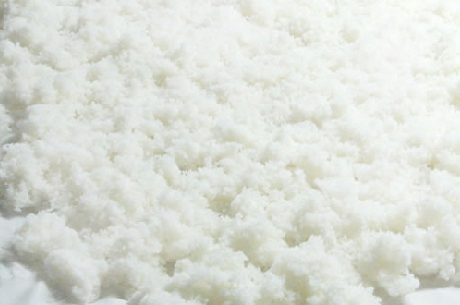
The kojimuro is a room where temperature and humidity are carefully controlled, in order to turn steamed rice into koji (malted rice).
The rice is put on a special table and sprinkled with koji mold, then wrapped in cloth. It takes at least 2 days to promote the propagation of koji mold and make koji.
The steamed, translucent, milky white rice is saccharified, and made even more white, with an aroma and sweet flavor similar to chestnuts.

The koji is put into a tank along with steamed rice and water in order to make shubo (fermentation starter). Fermentation starter preparation is the task of making the "base" for sake brewing, in order to grow yeast, which is the source of alcohol. Yoshida Sake Brewing uses pure, clean super soft water from Yasugi.
Because we use super soft water with low mineral content to feed the yeast, we must carefully prepare yeast according to the pace of its growth. We use shubo, which activates foam and is difficult to handle, so it is rarely used in the modern day. Foam fills the brewing tank, so only a small amount of shubo can be made.
This yeast is essential for the aroma and sour, sharp taste peculiar to Gassan, so we continue the difficult process of making it.
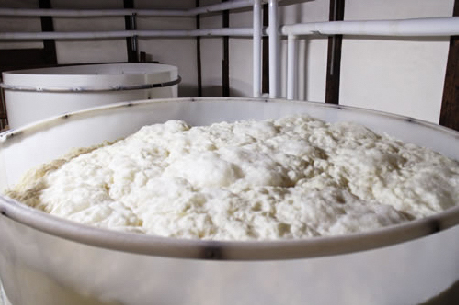
Great time and effort is spent to make koji, shubo, and steamed rice, which are then mixed with water in a preparation tank for fermentation.
Malted rice brings out chestnut aroma and umami flavor of rice, while foamy shubo creates a fruity aroma and sharp, slightly sour flavor. These ingredients combined take about one month to turn the steamed rice and water into moromi (fermentation mash), which is the base of Gassan sake.
(Rice starch is turned into sugar using koji mold.)

Moromi made over the course of a month is then filtered and separated into sake (liquid) and lees (solid).
The tank is connected to a machine that filters out the lees (automatic filtration press). Air is pumped into a silicone filter shaped like an accordion, which inflates like a balloon, squeezing the moromi between them. This precisely separates the sake (liquid) and lees (solid).
In the normal sake brewing process, sake made this way is put into the tank from the top. In our brewery, the filter is applied first, then the sake is put in the tank through the outlet, so as not to come in contact with oxygen.
When sake is transferred from the top, it spends more time in contact with air, promoting oxidation. In order to maintain the great flavor and aroma unique to Gassan, and keep the sake fresh, we transfer it to the tank in a matter completely different from the standard.
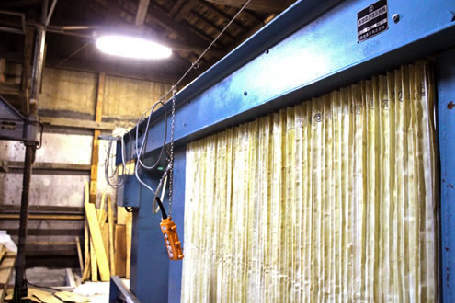
Just one week after the sake is transferred to the tank, it is pasteurized at 65˚ C, then bottled and stored in our warehouse in that state.
By storing the sake in bottles instead of typical tanks, exposure to oxygen is minimized, and quality is not degraded, creating the fresh, fruity, and sharp flavors that make Gassan so delicious.


The Hirose district of Yasugi City is located in the eastern part of Shimane Prefecture, a mountainous area blessed with a lush natural environment. It is a castle town surrounding the remains of Gassantoda Castle, which was widely known as an impregnable castle when it was the residence of the Amago clan who ruled the San'in region during the Sengoku period (also known as the "Warring States Period", 1467 - 1590). Yoshida Sake Brewing was founded as a sake brewery in 1743, patented by the Hirose Domain. The old family started brewing sake as "Yasuya Sakamise" in 1730. Even now, "安" (the Japanese character for "Yasu") remains on the chimney of our sake brewery, and the hopes, and the intent of old family remains with us. Including the history of the old family, we have continued to brew sake rooted in this Yasugi area for about 300 years. Just as we made the best sake "Ichibantaru" in the Edo period and presented it to the feudal lords of the Hirose Domain. In the modern day, we make sake so that our customers can taste the best sake in Yasugi.
